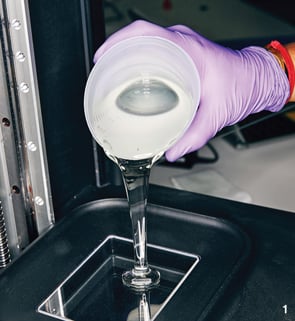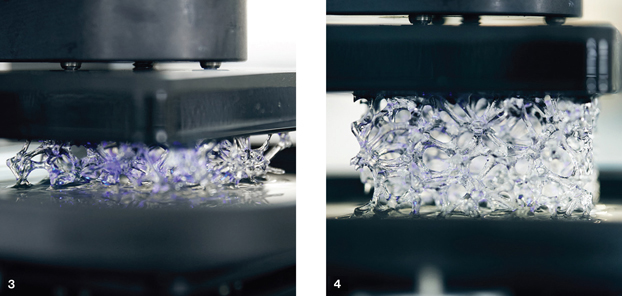A company’s novel technology could make custom medical devices and car parts— not to mention shoes that fit just right.
1. A technician pours viscous polymer precursors into the printer well. The window at the bottom lets in light from an underlying ultraviolet-light projector and is permeable to oxygen. 3-D printers can make objects that are impossible or expensive to make with molding, milling, and other conventional manufacturing processes. However, these printers work too slowly to be widely used in factories. That’s because today’s version of the technology builds up objects one layer at a time. It’s essentially 2-D printing over and over again, says chemical engineer Joseph DeSimone, founder and CEO of Carbon 3D, a startup in Redwood City, California. His company claims to have a technology that is 25 to 100 times faster, depending on the object and the material. DeSimone hopes Carbon 3D’s printers will be used to make airplane or car parts that are stronger and yet lighter than ones used today, helping to reduce fuel consumption. He also wants to make it possible to rapidly print custom shoe soles, fitted to the quirks of individual arches, and place printers in operating rooms to generate stents matched to patients’ arteries.
2-4. Frame by frame, the ultraviolet light projects the design into the chemical bath. Some of the light is visible as a violet glow.
5-6. As the exposed chemical precursors harden, a mechanical arm pulls the growing object out of the bath. A thin layer of oxygen at the bottom of the bath keeps the hardening patterns from sticking.
7. A technician removes the completed object, which took 17 minutes to print. The company says this structure can be made in seven minutes when the process is not slowed down for photographs.
A model of the Eiffel Tower being made out of the resin.
9. A pattern of struts inside this 3-D-printed cylinder of hard resin adds extra strength without adding much weight. This kind of design might be used to replace metal support structures in airplane seats, according to the company.
10–11 The printers can also build objects from bouncy, flexible elastomers, which could be well suited for wearable items like shoe soles and headphones. Elastomers are incompatible with traditional additive manufacturing, says DeSimone. Carbon 3D’s process is a variation on a method called stereolithography, which uses projected patterns of ultraviolet light to catalyze the formation of solid polymers from a pool of resin. Stereolithography is typically a stop-and-start process—the object being printed sticks to the bottom of whatever vessel it’s in and must be pried off after each flash of light. Repeating this process with each layer is slow and leaves the completed object mechanically weak where each layer connects to another. In Carbon 3D’s version, the pool of liquid resin sits in a vessel with a window at the bottom. The window is permeable like a contact lens, so it lets in not only light but also oxygen—which inhibits the chemical reaction just enough to prevent the polymer from solidifying on the bottom. That allows Carbon 3D to continuously print one layer on top of the next, which makes the process much faster and the resulting materials stronger, says DeSimone. “It looks like something growing out of a puddle,” he says. Other researchers have demonstrated printing systems that incorporate some of the techniques used in Carbon 3D’s machines, and some of these methods can print features with higher resolutions than the company’s process. DeSimone, who founded Carbon 3D in 2013 and is on leave from the University of North Carolina to work at the company, has $51 million in funding to further develop the printers and polymer materials that will be its first products. This March, the company came out of stealth mode with a Science paper describing its technology and a captivating video of a small blue model of the Eiffel Tower emerging rapidly from a viscous little pool. DeSimone says that while most commercial 3-D printing systems have been designed by mechanical engineers, his chemistry focus sets Carbon 3D apart. “We want to offer materials properties that haven’t been seen before,” he says.
|








Nenhum comentário:
Postar um comentário
Observação: somente um membro deste blog pode postar um comentário.